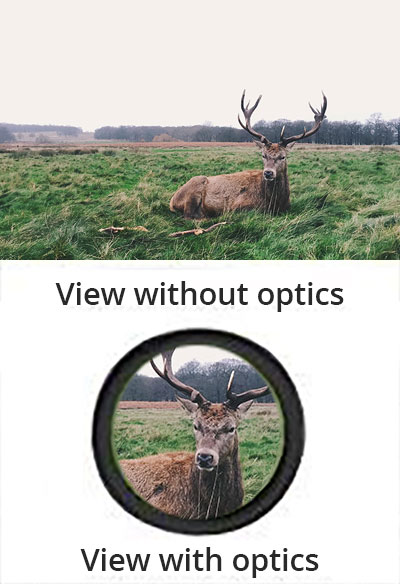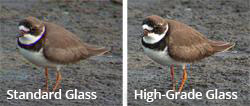In The Field | Cleaning Your Glass | Hunting Optics | Birding Optics | Scopes & Tripods | When to Upgrade | Understanding Optics
Whether you’re considering the purchase of a binocular or a spotting scope, you’ll want to know the optical device’s magnification. Magnification, or “power” as it’s sometimes referred to, is a number indicating how much larger an object appears when viewing it through the optic versus the naked eye. Thus, an 8x42 binocular magnifies your view eight times.
Fixed and Zoom
Magnification is the first number indicated in a binocular specification, e.g., 6x32, 8x42, and 10x50. These are considered fixed magnification because they have a single power. However, nearly all spotting scopes (but only a minority of binoculars) have variable magnification, more commonly called zoom. Zoom magnification is expressed as two numbers from lowest to highest power. Examples would be 15-45x60 and 20-60x80, the two most popular spotting scope configurations.
Power and Steadiness
It’s somewhat regrettable in optical jargon that “power” is synonymous with magnification. In everyday vernacular, adding power to something is generally deemed a desirable thing. However, a binocular with higher magnification doesn’t necessarily translate to a better view. Sure, objects will appear larger (closer to you), but high magnification binoculars are generally less easy to hold steady. This can have a critical impact on your ability to discern detail. Most individuals are fine with 6x and 8x, fewer can hold a 10x steady, but binoculars over 12x should probably be mounted on a tripod. This is why spotting scopes must always be mounted on a tripod; higher magnification makes them impractical to hold in your hands.

Brightness
Increasing magnification can also render an image that’s less bright. At the same aperture size (42mm, 50mm, etc.), as you increase magnification the image becomes less bright, and this is more obvious at dawn and dusk. Thus, a 10x42 binocular, technically having more “power” than an 8x42, will be less bright under low light conditions. More power isn’t always a good thing!
Final Word: Spotting Scope Eyepieces
Many spotting scope manufacturers sell eyepieces separately from their spotting scopes, offering the user a choice between fixed and zoom magnification. While zoom eyepieces are the most popular due to the versatility of being able to change the magnification for situations that demand either high or low power, fixed magnification eyepieces offer a wider field of view.
Invest in optics with the highest quality glass you can afford
Standard grades of optical glass offer good image quality in ideal lighting conditions. For the best performance in low light situations, it is necessary to consider high grades of glass.
High-grade glass types, such as ED, FL, and HD, offer noticeably enhanced resolution and color fidelity:

High-grade glass offers a more clear, vivid image than standard glass.
The increased image quality from high-grade glass is especially obvious when viewing in low light.
The objective lens is the lens at the end of a binocular or spotting scope that is farthest from your eyes.
The objective lens determines how much light the binocular or spotting scope can receive and how bright the resulting image will be. The objective lens size also affects overall equipment size.
Binoculars
The second number (8 x 42) refers to the diameter of the objective lens in millimeters. Objective lenses typically vary in size from 15mm–80mm.
Spotting Scopes
The last number (20–60 x 80) refers to the diameter of the objective lens in millimeters. Objective lenses typically vary in size from 40mm–100mm.
Optical Field of View is the actual distance across your viewing field (left to right) when looking through a binocular or spotting scope. It can be measured in two different ways: linear feet at 1,000 yards (also known as True Field of View) and angular degrees (or Apparent Field of View). You can easily convert from one measurement to the other by knowing that one angular degree is equivalent to 52.5 feet. Thus, if you know the angular field of view in degrees, multiplying that number by 52.5 will give you the linear field of view of feet at 1,000 yards. Likewise, dividing the linear field of view by 52.5 will give you the angular measurement.
There are a few positive viewing points regarding a wide field of view: It’s easier to aim and stay on a moving subject, therefore binoculars with a wide field are generally preferred by birdwatchers. A typical 8x42 binocular has a field of view around 340 feet at 1,000 yards or 6.5 angular degrees. Binoculars with a field of view 390 feet at 1,000 yards or above are generally considered wide field.

A common misunderstanding is that the objective lens diameter (32mm, 42mm, 50mm, etc.) is the field of view. Even binoculars with a narrow objective lens diameter can have a wide field of view; it's because it has more to do with the physical length of the binocular and the configuration and design of eyepiece lens elements. Hence, the field of view cannot be determined by the two numbers of a binocular, e.g. 8x42, 10x50, etc.; you must look at the manufacturer’s provided specification for it.
Close focus refers to the nearest distance you can focus a binocular or spotting scope. Close focusing is especially useful when viewing butterflies, dragonflies, wildflowers, and other subjects at extremely close range.
In binoculars, 3’ to 8’ is considered a “good” close focus for watching insects. Keep in mind that when you’re using a binocular at close focus the “two circles” will become farther apart. This is normal.
The overwhelming majority of spotting scopes generally don’t focus closer than 20’, but there are some exceptions. If you’re planning on watching your backyard bird feeders with a spotting scope, be sure your feeders are placed the proper distance from where you intend to conduct your viewing. The versatility of close focusing enhances your observations with nature by magnifying the critters right at your feet!
